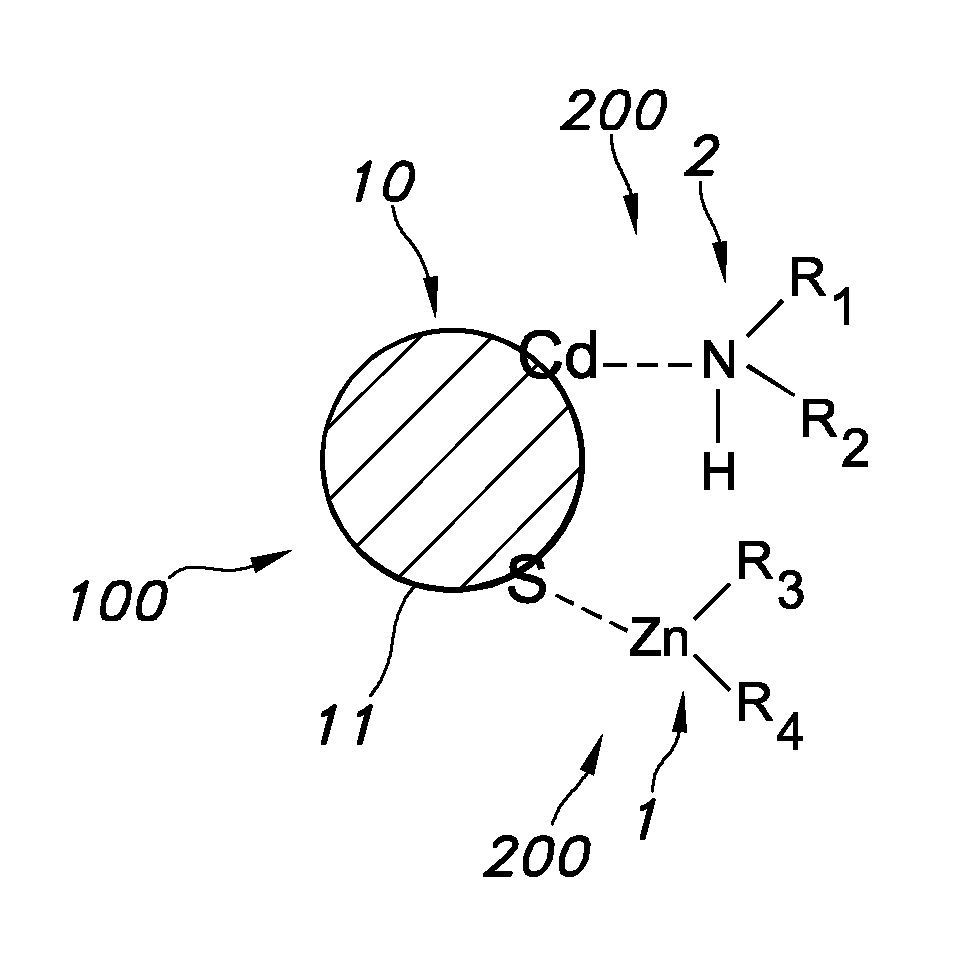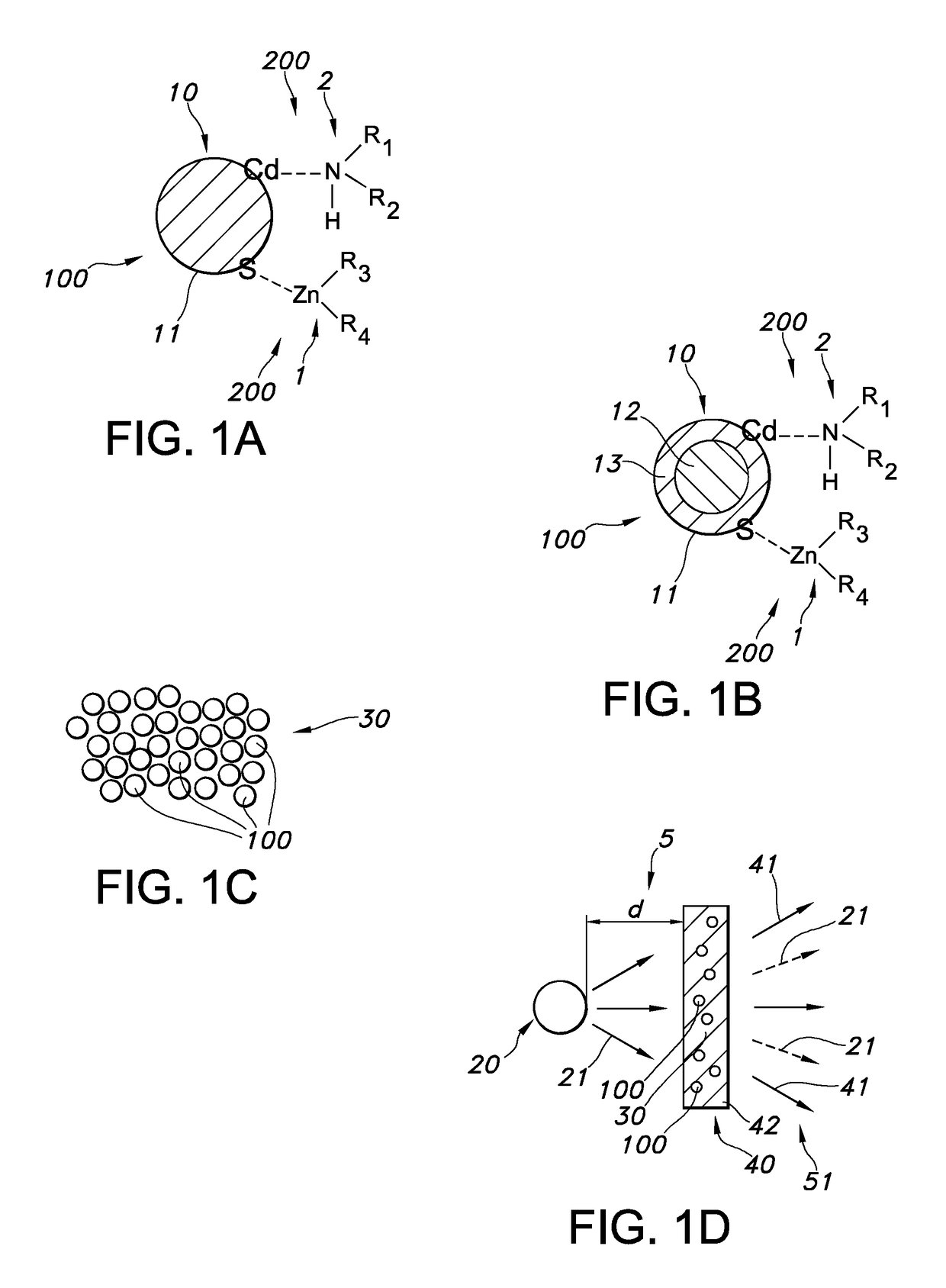Materials and methods for dispersing nano particles in matrices with high quantum yields and stability
a nano particle and nano-polymer technology, applied in the field of materials and methods for dispersing nano particles in matrices with high quantum yields and stability, can solve the problems of reducing the quantum yield and light transparency of nano particle/polymer mixture, and reporting capping molecules have rather low photochemical stability. , to achieve the effect of high quality, high light intensity and wide emission band
- Summary
- Abstract
- Description
- Claims
- Application Information
AI Technical Summary
Benefits of technology
Problems solved by technology
Method used
Image
Examples
experiment 1
Prepare QDs-Silicone Polymer Matrices as an Example of QDs-Sylgard PDMS:
[0083]Dissolve the Zn-PDMS and amino-PDMS modified QDs into the solvents such as toluene or chloroform to form a QDs solution. PDMS component, which contains PDMS monomers, such as Sylgard 184 (component B) are first added into the solution and stirring to give a clear mixture. Then the other component, which contains crosslinker and catalyst, such as Sylgard 184 (component A) A is added into the mixture at a desired weight ratio, in the case of Sylgard 184 the ratio is of 10%. The clear mixture then dried and cured at certain temperature, in the case of Sylgard 184 it is 150° C. for 30 min to give a transparent QDs-PDMS matrix.
experiment 2
Prepare QDs-Silicone Polymer Matrices as an Example of QDs-Silres:
[0084]Dissolve the above zinc undecylate and (3-Mercaptopropyl)-trimethoxysilane modified QDs into the solvents such as toluene or chloroform to form a QDs solution. Silres monomer, such as Silres 610 is added into the mixture at a desired weight ratio. The clear mixture then dried and cured at certain temperature, in the case of Silres 610 it is 200° C. for 30 min to give a transparent QDs-Silres matrix.
experiment 3
Prepare QDs-Silicone Polymer Matrices as an Example of QDs-Acrylates:
[0085]Dissolve the zinc methacrylate modified QDs into the solvents such as toluene or chloroform to form a QDs solution. Acrylates monomers, such as methyl methacrylate are then added into the solution. The mixture then stirred till clear and 1% wt photo initiator is added and then the mixture is cured under UV irradiation to give a transparent QDs-acrylates matrix.
Characterizations:
Material Characterization:
[0086]The components and structure of the QDs-silicone polymer composites could be easily detected. The structure could be characterized through the characterization methods of TEM, XRD. Components could be characterized by IR, NMR, UV-Vis, PL, ICPMS and XPS for the type, elements ratio of the components.
[0087]Analysis of thiol, amino or carboxydecyl terminated PDMS or Silane is through standard way for commercial product.
[0088]Analysis of Zn-carboxy or Zn-amino terminated PDMS or Silane through the standard w...
PUM
| Property | Measurement | Unit |
|---|---|---|
| wavelength | aaaaa | aaaaa |
| Tg | aaaaa | aaaaa |
| Tg | aaaaa | aaaaa |
Abstract
Description
Claims
Application Information
 Login to View More
Login to View More - R&D
- Intellectual Property
- Life Sciences
- Materials
- Tech Scout
- Unparalleled Data Quality
- Higher Quality Content
- 60% Fewer Hallucinations
Browse by: Latest US Patents, China's latest patents, Technical Efficacy Thesaurus, Application Domain, Technology Topic, Popular Technical Reports.
© 2025 PatSnap. All rights reserved.Legal|Privacy policy|Modern Slavery Act Transparency Statement|Sitemap|About US| Contact US: help@patsnap.com



